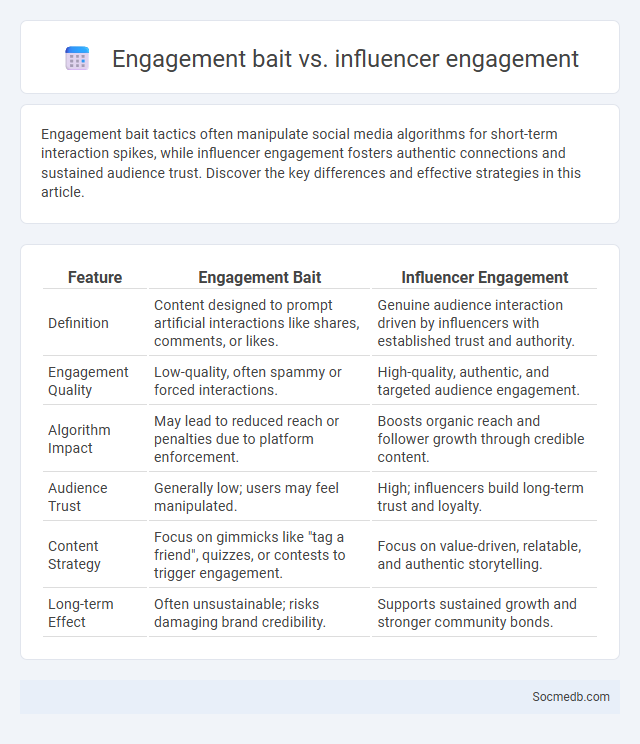
Photo illustration: Engagement bait vs Influencer engagement
Engagement bait tactics often manipulate social media algorithms for short-term interaction spikes, while influencer engagement fosters authentic connections and sustained audience trust. Discover the key differences and effective strategies in this article.
Table of Comparison
| Feature | Engagement Bait | Influencer Engagement |
|---|---|---|
| Definition | Content designed to prompt artificial interactions like shares, comments, or likes. | Genuine audience interaction driven by influencers with established trust and authority. |
| Engagement Quality | Low-quality, often spammy or forced interactions. | High-quality, authentic, and targeted audience engagement. |
| Algorithm Impact | May lead to reduced reach or penalties due to platform enforcement. | Boosts organic reach and follower growth through credible content. |
| Audience Trust | Generally low; users may feel manipulated. | High; influencers build long-term trust and loyalty. |
| Content Strategy | Focus on gimmicks like "tag a friend", quizzes, or contests to trigger engagement. | Focus on value-driven, relatable, and authentic storytelling. |
| Long-term Effect | Often unsustainable; risks damaging brand credibility. | Supports sustained growth and stronger community bonds. |
Understanding Engagement Bait: Definition and Tactics
Engagement bait refers to posts on social media designed specifically to manipulate users into interacting through likes, shares, comments, or other forms of engagement by exploiting platform algorithms. Common tactics include asking users to tag friends, react with specific emojis, or comment answers to simple questions to boost visibility artificially. Recognizing these strategies helps you avoid falling for inauthentic content and promotes genuine interaction with meaningful posts.
What Is Influencer Engagement? Key Concepts Explained
Influencer engagement measures the interaction and connection between influencers and their audience through likes, comments, shares, and direct messages. Understanding your influencer engagement rate helps gauge the authenticity and impact of campaigns, ensuring your brand reaches a genuinely interested community. High engagement reflects strong relations, boosting visibility and trust in your social media marketing efforts.
Engagement Bait vs Influencer Engagement: Core Differences
Engagement bait relies on low-effort tactics like asking users to like, share, or comment to artificially boost interaction, often leading to reduced reach due to platform algorithms penalizing such content. Influencer engagement, on the other hand, builds authentic connections through relatable content and trusted personalities, driving meaningful interactions and sustained audience growth. Understanding these core differences helps you invest in genuine engagement strategies that foster long-term community trust and platform algorithm favorability.
How Algorithms Detect Engagement Bait
Social media algorithms detect engagement bait by analyzing patterns such as repetitive phrases, unusual spikes in user interactions, and requests for likes, shares, or comments that manipulate platform metrics. Machine learning models evaluate user behavior data and flag posts with unnatural engagement, helping to reduce the visibility of engagement bait content. Platforms like Facebook and Instagram continuously update their detection systems to improve accuracy in identifying and demoting engagement bait in user feeds.
Authentic Audience Interaction: Influencer Engagement Strategies
Authentic audience interaction on social media requires influencers to prioritize genuine engagement through personalized responses and meaningful content that resonates with their followers' interests and values. Strategies such as utilizing live Q&A sessions, interactive polls, and behind-the-scenes storytelling foster trust and deepen community connections. Leveraging data analytics to tailor content ensures influencers maintain relevance while enhancing user experience and retention.
Negative Impacts of Engagement Bait on Social Media Reach
Engagement bait tactics on social media, such as urging users to like, share, or comment excessively, result in reduced reach due to platform algorithms demoting such content. These practices degrade user experience by flooding feeds with low-quality posts, leading to lower organic engagement rates over time. Social media platforms increasingly penalize engagement bait, prioritizing authentic interactions to maintain genuine community growth.
Measuring Engagement Quality: Metrics That Matter
Measuring engagement quality on social media involves analyzing metrics such as meaningful comments, shares, and time spent on content rather than just likes or follower counts. Metrics like sentiment analysis, click-through rates, and conversion rates provide deeper insights into audience interaction and content effectiveness. Tracking these engagement metrics helps brands optimize strategies to foster authentic relationships and increase overall social media impact.
Best Practices for Boosting Genuine Engagement
Creating authentic connections on social media requires prioritizing genuine interactions by responding promptly to comments and messages, fostering meaningful conversations, and sharing content that resonates with Your audience's interests and values. Utilizing data-driven insights to post consistently during peak engagement times helps maximize visibility and interaction. Encouraging user-generated content and leveraging influencers with shared values further amplify Your brand's credibility and trustworthiness.
Case Studies: Successes and Failures in Engagement Strategies
Analyzing case studies of social media engagement reveals how brands like Nike leverage personalized content to boost user interaction exponentially. Conversely, failures often stem from ignoring audience feedback or misreading platform algorithms, as seen in the backlash against Pepsi's controversial ad campaigns. Understanding these successes and failures equips you to craft strategies that resonate authentically with your target audience and maximize engagement.
Choosing the Right Approach: Engagement Bait or Influencer Engagement?
Choosing between engagement bait and influencer engagement hinges on long-term strategy and authenticity. Engagement bait tactics, like clickbait or overly promotional posts, often result in lower quality interaction and risk algorithm penalties on platforms such as Facebook and Instagram. Conversely, influencer engagement leverages trusted voices within targeted niches to foster genuine connections, drive higher engagement rates, and enhance brand credibility across social media networks.
 socmedb.com
socmedb.com